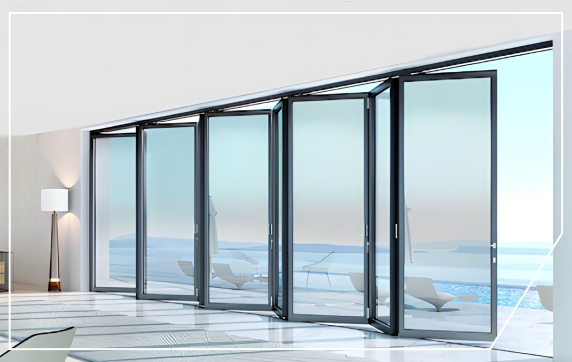Considering origami-inspired folding doors for your home? Folding doors are becoming increasingly popular in contemporary architecture. From offering maximum natural light to versatile and modern aesthetics, they’re a top choice for homeowners and designers seeking transformative, functional, and elegant door designs.
In this guide, you’ll see how complex geometries of these folding doors invite adaptable and sustainable designs for your home.
Let’s get started!
What is Kinetic Architecture?
Kinetic architecture involves building elements that are capable of movement, transformation, or adaptation, such as folding doors inspired by origami, which shift form and function dynamically.
Unlike static structures, these intricate designs embrace systems that grant components like facades, roofs, or even entire rooms access to change shape, position, or function. Environmental factors, such as sunlight or wind, pre-programmed sequences, or user interaction, can trigger the kinetic movement of these structures.
Thus, AluK’s kinetic architecture design in folding doors offers responsive, adaptable structures that enhance aesthetic appeal and improve functionality (e.g., energy efficiency, light control).
We ensure our customers get a more interactive experience, balancing the lines between art, all the engineering aspects, and the built environment.
Origami Principles in Architectural Design
Origami principles in architectural design compose folding techniques to craft structures that are aesthetically pleasing and visually striking.
By making use of precise folds and geometric interference, this method helps minimise material usage, ultimately leading to maximum spatial efficiency. These structures offer rigidity, strength, plus sturdiness, resulting in efficient and lightweight designs.
Moreover, origami designs enable elements such as facades or entire structures to transform dynamically, responding to environmental conditions or individual needs. These unique spatial solutions lead to sustainable building practices by minimising waste and optimising material usage.
Benefits of Folding Doors in Modern Spaces
Folding doors bring the following advantages to modern spaces:
The benefits of folding doors in modern spaces include the following:
1. Open Up to Natural Light
Folding glass doors are best for filling your interiors with bright light, and kudos to their spacious glass panels. An inviting atmosphere, reduced artificial lighting usage, and an enhancement of mood and overall well-being are the benefits you receive with the installation of folding doors.
2. Expand Your Living Space with Indoor-Outdoor Connectivity
The doors flawlessly merge indoor space with the outside world. The wide openings encourage easy access to decks, gardens, or patios, and you enjoy that lovely fresh air that calms your anxious nerves.
3. Unfold More Room
Folding doors slide and stack to one side, eliminating the need for swing clearance, helping save space while creating wide, open transitions between spaces.
4. Enhance Property Value and Visual Charm
Their modern and sleek design grabs every eyeball and elevates the look of your home, suiting various architectural styles. These innovative designs may also increase the resale value of your property.
5. Maximise Savings With Energy Efficiency
Folding glass doors maintain indoor temperatures, saving on big bills with the help of
double or triple-glazing, low-emissivity (Low-E) coatings, and weatherproof seals.
6. Dynamic Designs are a Plus!
From customizable configurations to optional tracks for mesh or blinds, folding glass doors offer versatile design solutions that seamlessly align with your space’s style and functional needs.
7. No Worries for Security
Modern designs with AluK systems feature multi-point locking, robust profiles, and clean lines, delivering enhanced security while maintaining a sleek, contemporary aesthetic.
Real-World Applications
Sliding doors are gaining the much-deserved attention in various real-world applications due to their unique fusion of dynamic functionality, exquisite appeal, and space-saving capabilities.
Here's what their uses are:
1. Commercial and Residential Interiors
Origami doors extend space in small interiors by folding compactly. They offer you flexible space division for adaptable layouts.
Besides their functionality, their graceful and geometric movement acts as a magnet, stamping an aesthetic statement in modern designs.
2. Retail and Hospitality
Businesses utilise them for adaptable dining areas, engaging shop fronts, and to blur the boundaries between indoor and outdoor spaces.
3. Architectural Facades
The origami principles in folding doors are scaled up for kinetic elements that firmly control sunlight, offer proper ventilation, and transform any home’s or building's appearance.
4. Temporary and Deployable Structures
The intrinsic "flat-pack" nature of folding doors makes them ideal for structures such as emergency shelters or pop-up pavilions. These versatile origami doors offer visual appeal for adaptable and efficient spaces.
Final Thoughts
These folding doors are not entryways; these are kinetic marvels that embody a lyrical blend of art and engineering.
Their ability to transform spaces into a heavenly feel, maximise natural light, and impeccably connect indoor and outdoor environments goes beyond traditional functionality.
By embracing innovative origami principles, these doors not only offer hands-on benefits like space optimisation and energy efficiency but also elevate a structure’s aesthetics.
If you were previously indifferent but have since developed an appreciation, then AluK is all you need!
Looking for more innovative designs? Give us a call or send us a DM to let us share our incredible samples with you and hear about your needs!
Wanting to reach out to us? Speak to our experts now!
Frequently Asked Questions (FAQs)
Q1: What is kinetic architecture, and how do folding doors fit into it?
A1: Kinetic architecture is a design that lets buildings change or move to fit different needs. Folding doors are part of this because they can open or close to quickly change a room’s size and shape, making the space more flexible and functional.
Q2: Are folding doors suitable for both residential and commercial architecture?
A2: Yes, folding doors are versatile and can enhance both residential and commercial spaces, creating flexible areas for various uses.
Q3: What materials are best for architectural folding doors?
A3: Aluminium is best for folding doors as it is lightweight, strong, and low-maintenance. Wood offers natural beauty but can warp and requires constant upkeep. uPVC is affordable but not sturdy and durable in the long run. Aluminium ensures strength and a sleek design.
Q4: Do folding doors improve energy efficiency?
A4: Folding doors enhance energy efficiency through the use of insulated (thermally broken) profiles, high-performance glazing options like low-E double or triple glass, and tightly sealed designs that minimize air leakage.
Q5: How does origami inspire door design?
A5: Origami inspires door design by using folding techniques to create space-saving, flexible doors with unique geometric patterns. These doors combine art and function, allowing smooth movement and adding modern, eye-catching aesthetics to spaces.



